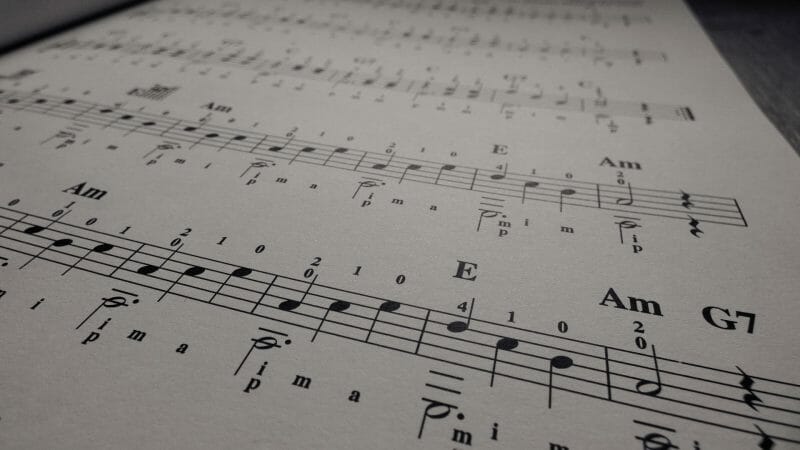In my country (New Zealand), it’s the height of summer, when many of us kick back at the beach, bach, or bush.
Invariably someone’s brought an old guitar. And pretty soon, there’s a jam and a sing-along of party favorites, old and new.
If you’re the one on the fretboard, you notice very quickly that a ton of hits use the same chords. While the tunes and the words change, there’s tons of repeating chord sequences in song after song.
So whether you’re writing your next hit or learning to play enough songs for your next party, it helps to get to grips with these patterns or progressions of chords.
By the end of this article, you’ll not only know what a chord progression is (and why they work), but also many of the most common chord progressions in music.
Get industry-quality every time (steal this framework)
I’m guessing you’re here because you want to make your mixes sound professional.
We put together a brief training that covers a totally new approach to music production. Until now, everyone has been teaching production totally backward.
Just click below to watch.
But if you just want to learn about Chord Progressions specifically, keep reading!
What Actually Is a Chord Progression?
A chord progression is the order chords are played, one after another, in a song or a piece of music. The chords you use, and the order you play them in make up the harmony of a song.
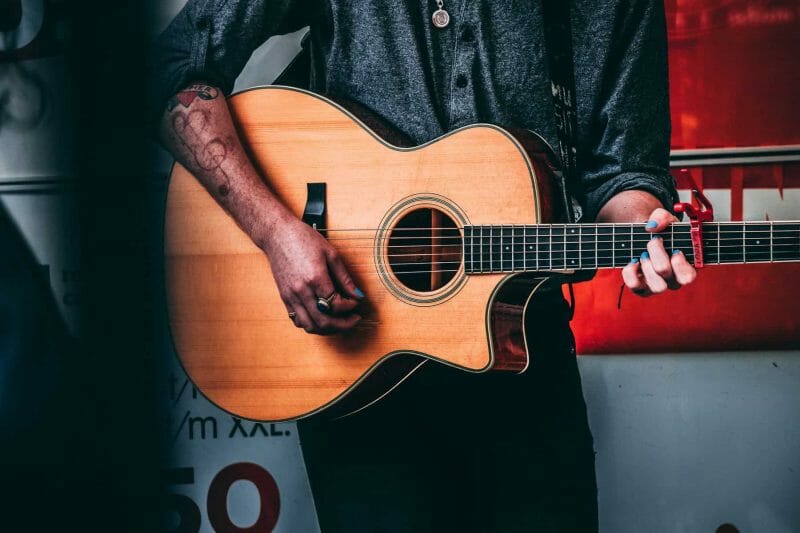
Like most of music, chords and their progressions come in patterns. A chord progression is just that – the pattern of chords in songs you play or write.
Songwriters want to put chords together that sound good. More importantly they want chords that feel good…or sad…or angry, tense, moody, sexy, whatever!
As songwriters, the chords you use and the way they’re put together is important. It can help create the melody or give context to how the melody makes us feel.
You can have as many chords as you like or work with just two – a progression has to have at least two. But a song can work with even a single chord.
So being able to use a chordal instrument, like a guitar or piano, is a powerful songwriting tool. Because here’s the thing – there aren’t many instruments that actually play chords (i.e., two or more notes at once).
Guitars, piano, and synths rule supreme here.
How Do Chord Progressions Work?
Many chord progressions will be super familiar to you.
As citizens of the 21st century, you will have absorbed many of these from contemporary music, without even being aware of it. So don’t panic.
But it does help to understand what’s going on. Then you can intentionally create amazing emotional landscapes in your own songs!
So here’s a little basic music theory…
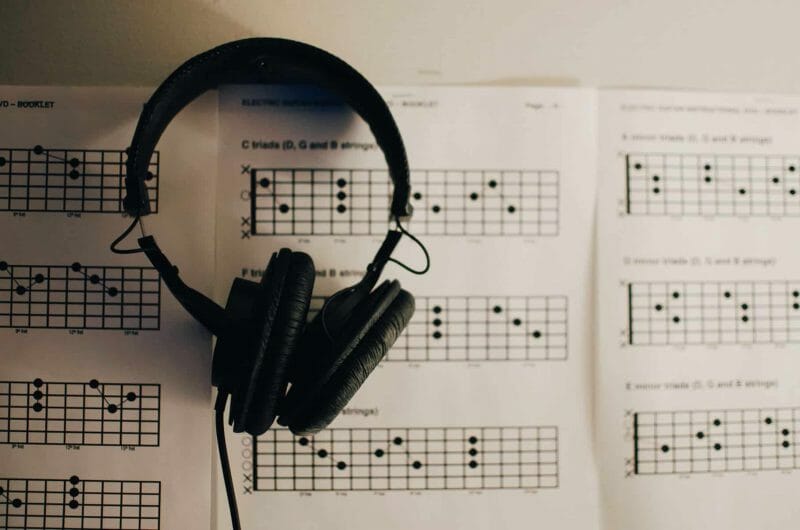
First up, chords in a progression work together because they’re in the same key.
The notes in the key (the scale) are put together to build that key’s chords. So if I’m writing a song in the key of C major, I’ll use chords made up of the notes from the C major scale.
Here are the notes in the C major scale:
| C | D | E | F | G | A | B |
And here are the 7 basic chords you can create just using the notes from this scale:
| C | D | E | F | G | A | B |
| E | F | G | A | B | C | D |
| G | A | B | C | D | E | F |
| C major | D minor | E minor | F major | G major | A minor | B diminished |
Those are the chords in my available “chord alphabet” that I have in C major. I can make any progression I want with these 7 chords.
This pattern of 3 major/3 minor/1 diminished chord is the same no matter which of the twelve major keys you use.
Here’s a trick that musicians use to tell which chords to play next, no matter what key you’re in:
Instead of writing out chords, they’ll use Roman numerals. Uppercase for major chords and lowercase for minor chords. A superscript circle is added for the diminished chord.
| I | ii | iii | IV | V | vi | vii° |
Because every major key follows the same structure, using Roman numerals instead of chord names means you can write a chord progression and put it in any key you want.
And those chords will always sound the same!
And here’s what they look like all together:
| I | ii | iii | IV | V | vi | vii° |
| Major | Minor | Minor | Major | Major | Minor | Diminished |
| C | Dm | Em | F | G | Am | B° |
| D♭ | E♭m | Fm | G♭ | A♭ | B♭m | C° |
| D | Em | F♯m | G | A | Bm | C♯° |
| E♭ | Fm | Gm | A♭ | B♭ | Cm | D♭° |
| E | F♯m | G♯m | A | B | C♯m | D♯° |
| F | Gm | Am | B♭ | C | Dm | E♭° |
| G♭ | A♭m | B♭m | C♭ | D♭ | E♭m | F° |
| G | Am | Bm | C | D | Em | F♯° |
| A♭ | B♭m | Cm | D♭ | E♭ | Fm | G° |
| A | Bm | C♯m | D | E | F♯m | G♯° |
| B♭ | Cm | Dm | E♭ | F | Gm | A° |
| B | C♯m | D♯m | E | F♯ | G♯m | A♯° |
See how as your key (I) goes up by one note, the rest of the chords go up by a single note too?
Now, there’s a different pattern for all the twelve minor keys too.
And here’s what happens with the minor keys. The same number of minor/major/diminished chords are used but in a different mix.
So for C major’s relative minor, A minor, we get this pattern of chords to use in our song:
| A minor | B diminished | C major | D minor | E minor | F major | G major |
You could also write it like this:
| i | ii° | III | iv | v | VI | VII |
Just like the major keys, you can apply this pattern to whatever minor key you are in.
What Are Some Famous Chord Progressions?
Now that you understand how to write chord progressions, let’s look at some time-tested examples. If you’re trying to write a song, these are a great place to start:
Three Is a Magic Number: I–IV–V–I
That’s right – all hail the three-chord thrash!
But there is enough of a journey here (I–IV) and a very clear resolution (V–I). It’s supported the entire genesis of rock and roll through the blues for the better part of a century.
This progression still dominates rock music today, from Tom Petty to Metallica, The Beatles to the White Stripes. And it hasn’t outstayed its welcome.
So if you are in C major (I), you add F major (IV) and G major (V). Roll on back to C major, and you’ve got yourself a bona fide chord progression.
The trick is how long you spend on each of those chords, what ‘feel’ you apply to the rhythm, and what variations you throw in the mix.
These are also some of the first open chords you learn as a guitarist. What’s not to like?
If you tinkle the ivories, these are all ‘white keys.’ This chord progression is beloved by beginner pianists.
Remember, whatever key you’re working in, the I chord will (almost) always start and finish the song. It’s home base, really.
When creating or using a chord progression, decide what your I is. The second chord you choose after that will set up the progression.
Here’s another famous choice:
Show Me the Money! I–V–vi–IV
Hooktheory.com found this insanely successful chord progression all over the Billboard charts (in over 1300 songs).
Artists like Lady Gaga (“Edge of Glory”), Journey (“Don’t Stop Believing”), the Beatles (“Let It Be”), and Maroon 5 (“She Will Be Loved”) have used it across the decades.
So can you. And it has three very close friends…
I–IV–vi–V
I–vi–IV–V
vi–IV–I–V
These chord progressions can run through the whole song. Use different melodies on top for the verse, chorus, and a bridge.
But different songs and different sections within those songs vary the number of beats on each of the chords. This gives subtle variations so we don’t all go bananas.
All the Feels! i–v–iv–i
Here are two useful chord progressions for the minor keys:
i–v–iv–i worked a treat in REM’s “Losing My Religion.” And this backwards-down-the-minor-scale maneuver, i–VII–VI–i, is well-illustrated in Bob Dylan’s (and Jimi Hendrix’s version) “All Along the Watchtower.”
What About the All the Other Chords? How Do They Fit In?
Well, there are some rules that work well here.
Like I said before, choose what key you are in. Then it’s the second chord you choose after I that sets up your chord progression.
Here’s a great resource that will help. It’s a cool summary of where to go after I, and you’ll see there is a real flow here.
Use it like a playbook for a football game. There are options that work more often than not.
This chart comes from Walter Piston’s book, Harmony, called the Table of Usual Root Progressions.

Now I know all the chords here are uppercase, but this chart is generic. It works for both our major and minor diatonic progressions.
If we’re writing a song in C major, we know we’ve got these chords we can use.
| I | ii | iii | IV | V | vi | vii° |
| C major | D minor | E minor | F major | G major | A minor | B diminished |
So if we start with I (C major), the Table of Usual Root Progressions reminds us that usually we’d go next to IV (F major) or V (G major). Sometimes we might go to the vi (A minor) chord, less often we’d use ii (D minor) or iii (E minor).
And if we check back on our famous chord progressions, that’s exactly what’s going on!
Say we choose to go to IV (F major) as our second chord in the song. Where do we go next?
Quick cheat sheet reference to the Table of Usual Root Progressions, and this is the advice:
IV is (usually) followed by V, sometimes I or ii, less often iii or vi.
So in C major, that F major (IV) would be followed by V (G major). Or you can go back to I (C major) or ii (D minor). Or maybe we use iii (E minor) or vi (A minor).
Quick cross-reference to the chart-topping progressions, and again, that’s exactly what happens.
How Come This Works?
It’s got to do with two things.
- How many notes each chord within the progression shares with another.
- The sense of movement or direction that this sharing brings.
Simple chords in the same scale can share no notes, one note, or two notes.
Maybe two of our chords only have one note difference, like this first example (C–E–G and E–G–B). That change of one note gives us a subtle sense of movement.
Something’s changed, but not too dramatically. We’ve leaned away, perhaps.

In the second example, there are two notes changing from the F–A–C to the C–E–G. This gives a stronger sense of stepping away.
There is still a shared point of connection with the C note, though.
The final example is where the two chords share no notes at all, F–A–C to E–G–B, even though they’re from the same scale. All three notes are different.
The change between these two chords is the most abrupt and sounds more like a jump away from home base.
What this means is that your song can tell much of its emotional journey clearly without singing a single word. It only needs the movement of note changes with the chord progression.
The sensation of directional change or movement can be dramatic, clear, or more gentle.
The point of all this is there are options. It’s not a crap shoot!
Exploring what different choices you can make in your own chord progressions can open up a whole new language in your music. But don’t be afraid to put your own spin on the tried and tested progressions, too.
So How Do I Make My Own Chord Progression?
There’s a lot to be learned from transcribing progressions of your favorite songs.
Some folks recommend doing that and then writing your own melody over the top.
But you can also build from the bottom up.
Step 1: Pick an Instrument
Keyboard or guitar, acoustic or electric, analog or digital. Something you can build chords with easily, i.e., play more than two notes at a time.
Step 2: Pick a Key
This pretty much determines the first chord (I or i) you’ll use and return to. For example, I might pick the key of C Major.
Step 3: Pick Either the Major or Minor Cheat Sheet
This helps limit the chords you have immediately available.
Don’t worry, you can always throw in a curveball chord anytime if it sounds good. But these formulas can be a springboard.
Major Key
| I | ii | iii | IV | V | vi | vii° |
Minor Key
| i | ii° | III | iv | v | VI | VII |
Step 4: Pick the Second Chord
From I or i, you can choose any other chord in the cheat sheet you picked. There are just more common or familiar choices.
Use the Table of Usual Root Progressions for inspiration.
Step 5: Pick a Feel
Whatever your mood dictates here – groove and tempo. Get a pulse going between your first and your second chord.
How many beats are you going to have on each chord? Not every chord needs to fill the bar.
“Sweet Home Alabama” effectively uses two beats on V, two beats on IV, and four on I.
What kind of mood does the chord change give you? Is two chords enough of a “journey” for your song? If not…
Step 6: Add Another Chord
Have a look at some of the options that the Table of Usual Root Progressions suggests. Try them out.
What sounds good to you? What really clicks with you? What have you never tried before?
Step 7: Create a Rough Demo
Put your possibilities on your phone or DAW.
Remember the chord progression is the infrastructure for your song. It can suggest emotion before a single note is even sung.
You may want to use different progressions between your verses and your chorus. Or you can use the same one the whole song through.
When you listen back to the raw recordings, what emotion do you experience? That’s what you’re trying to capture at this stage.
Step 8: Try Spicing It Up With Out-Of-Key Chords
OK, if you’re really getting nothing from what you’ve recorded, bring out a curveball. Borrowing chords from another key can reinvigorate a boring progression.
TLC’s “No Scrubs” uses a progression that’s basically a minor i-iv.
But it uses an out-of-key V7. That really strengthens the sequence of i–iv–V7–iv that’s repeated through the entire song.
This also brings up the idea of chord extensions, which is a whole other topic!
But those extra notes – like sevenths and suspensions, sixths and elevenths – can bring so much flavor it hurts.
You can also change keys. The circle of fifths will help you find a great key to change to.
Step 9: Try Simplifying With Fewer Chords
Some songwriters vary the chord progressions within the lines of their verses, though not usually between verses themselves.
Better three chords in a song than thirty, as a general rule of thumb.
It’s useful to remind yourself that the word progression implies a direction.
We, your audience, may delight in surprises. But we still want to know the general direction we’re headed!
Simplify your Writing with these Chord Progression Cheatsheets
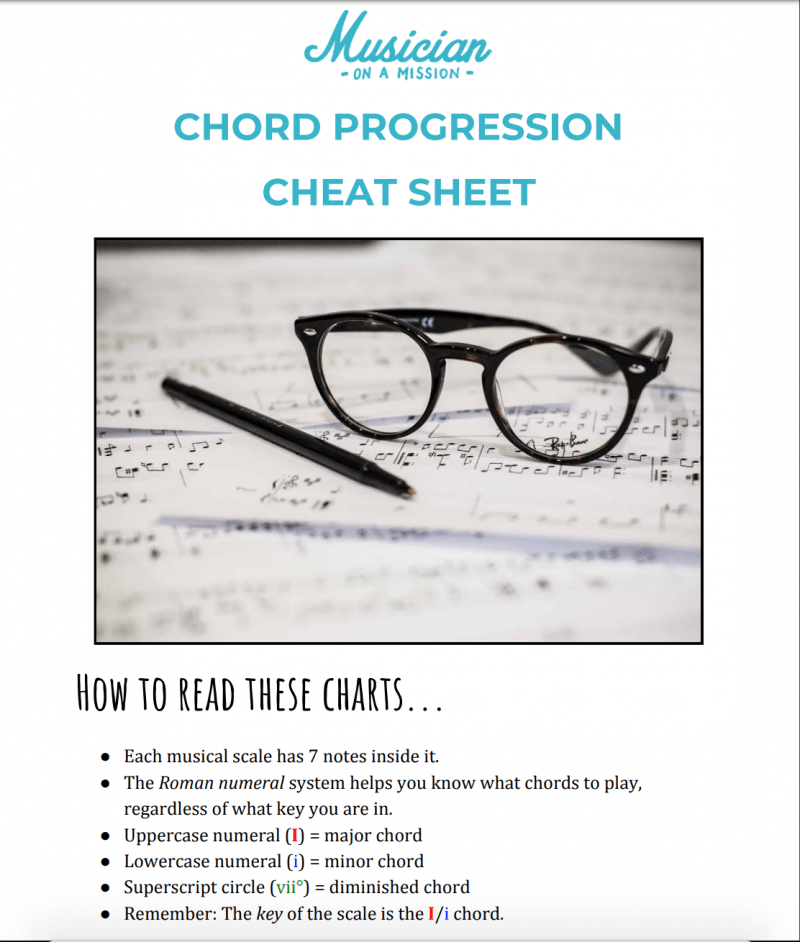
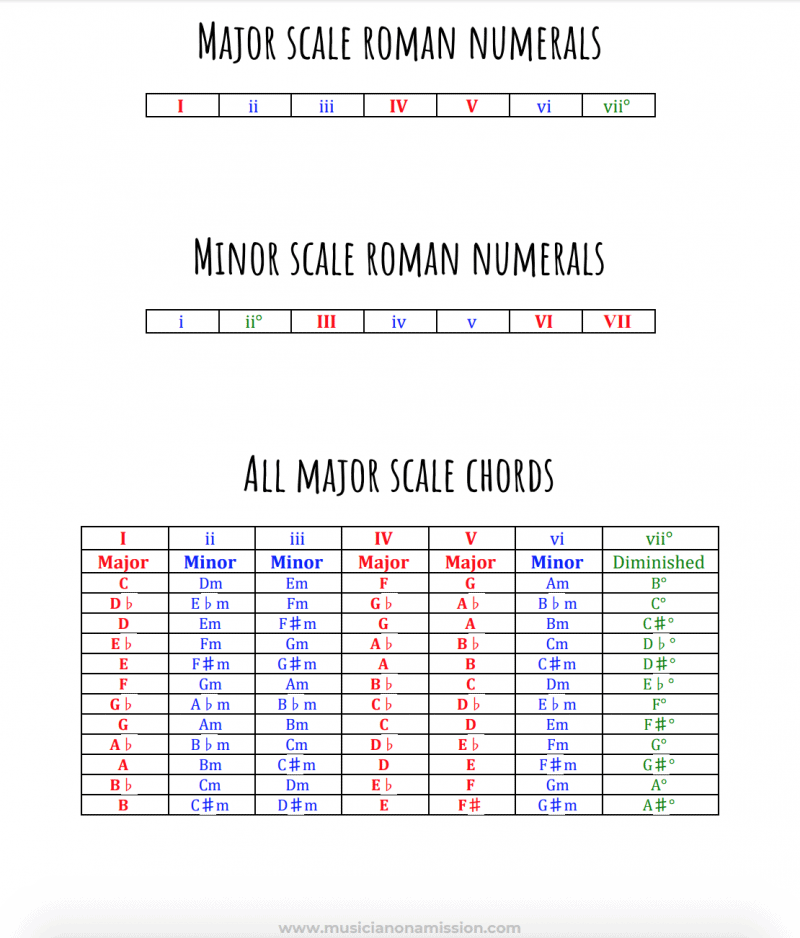

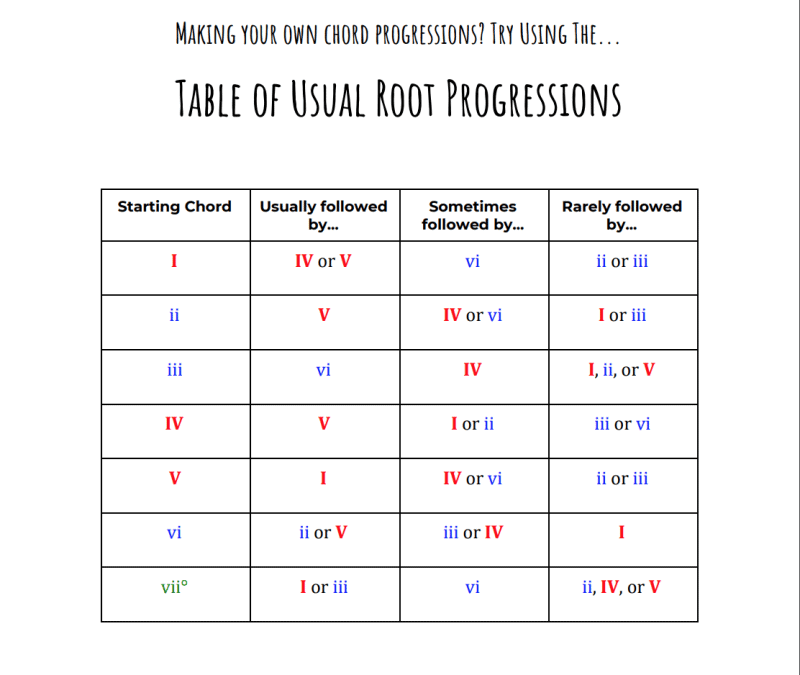
Conclusion: Chord Progressions
My hope after reading this is that you’ll experiment with a new chord progression or two. Also take a second look under the hood of your favorite songs for influences!
I look forward to hearing the results.
Next Steps
If you want to dig deeper into music production and learn what it actually takes to make mixes that sound pro…
And you’re an intermediate or advanced producer…
Be sure to check out the free masterclass:
Enjoy!


